Characterization of Failure Strain In Fiber Reinforced Composites: Under On-Axis and Off-Axis Loading
Abstract
1. Introduction
2. Materials and Methods
2.1. Samples Preparations
2.2. Testing
3. Results and Discussions
3.1. On-Axis Loading
3.2. Off-Axis Loading
4. Conclusions and Future Perspective
- (1)
- Under on-axis loading, epoxy/fiber composite show brittle behavior, whereas under off-axis loading, they show ductile behavior.
- (2)
- Failure strain in on-axis loading ranged from 1.3% to 3.75%, which is relatively low. This brittle behavior limits the applications of epoxy/fiber composites under on-axis loading conditions.
- (3)
- In off-axis loading, glass/epoxy composites showed a good response with a 56% loss in tensile strength and 90% gain in failure strain. The failure strain ranged from 2.72% to 17.58% in off-axis loading for all composites.
- (4)
- It is recommended that whenever ductility or failure strain in the composite is desired, use glass fiber as a single layer or in hybridization with any natural fiber reinforcement.
- (5)
- Jute/epoxy composite revealed inferior mechanical properties compared to carbon/epoxy and glass/epoxy in both on and off-axis loading. Therefore, it is recommended to use jute fiber only in hybridization with any synthetic fiber.
Author Contributions
Funding
Data Availability Statement
Conflicts of Interest
References
- Al Rashid, A.; Khan, S.A.; Al-Ghamdi, S.G.; Koç, M. Additive manufacturing: Technology, applications, markets, and opportunities for the built environment. Autom. Constr. 2020, 118, 103268. [Google Scholar] [CrossRef]
- Rashid, A.A.; Khan, S.A.; Al-Ghamdi, S.G. Critical Review on 3DP Concrete trends, needs and research recommendation. In International Conference of Materials and Engineering Technology (TICMET’20); Gaziantep, Turkeys, 5-7 November 2020.
- Al-Rashid, M.A.; Nahiduzzaman, K.M.; Ahmed, S.; Campisi, T.; Akgün, N. Gender-Responsive Public Transportation in the Dammam Metropolitan Region, Saudi Arabia. Sustainability 2020, 12, 9068. [Google Scholar] [CrossRef]
- Al-Rashid, M.A.; Goh, H.C.; Harumain, Y.A.S.; Ali, Z.; Campisi, T.; Mahmood, T. Psychosocial Barriers of Public Transport Use and Social Exclusion among Older Adults: Empirical Evidence from Lahore, Pakistan. Int. J. Environ. Res. Public Heal. 2020, 18, 185. [Google Scholar] [CrossRef]
- Heimbs, S.; Schmeer, S.; Middendorf, P.; Maier, M. Strain rate effects in phenolic composites and phenolic-impregnated honeycomb structures. Compos. Sci. Technol. 2007, 67, 2827–2837. [Google Scholar] [CrossRef]
- Khalid, M.; Al Rashid, A.; Sheikh, M. Effect of Anodizing Process on Inter Laminar Shear Strength of GLARE Composite through T-Peel Test: Experimental and Numerical Approach. Exp. Tech. 2021, 1–9. [Google Scholar] [CrossRef]
- Winkelmann, C.; Kim, S.S.; La Saponara, V. Design and development of hybrid composite bistable structures for energy absorption under quasi-static tensile loading. Compos. Struct. 2010, 93, 171–178. [Google Scholar] [CrossRef]
- Shah, D.U.; Schubel, P.J.; Clifford, M.J.; Licence, P. The tensile behavior of off-axis loaded plant fiber composites: An insight on the nonlinear stress-strain response. Polym. Compos. 2012, 33, 1494–1504. [Google Scholar] [CrossRef]
- Al Rashid, A.; Imran, R.; Khalid, M.Y. Determination of opening stresses for railway steel under low cycle fatigue using digital image correlation. Theor. Appl. Fract. Mech. 2020, 108, 102601. [Google Scholar] [CrossRef]
- Gowtham, H.; Pothnis, J.R.; Ravikumar, G.; Naik, N. High strain rate in-plane shear behavior of composites. Polym. Test. 2013, 32, 1334–1341. [Google Scholar] [CrossRef]
- Callens, M.; Gorbatikh, L.; Verpoest, I. Ductile steel fibre composites with brittle and ductile matrices. Compos. Part. A: Appl. Sci. Manuf. 2014, 61, 235–244. [Google Scholar] [CrossRef]
- Schmeer, S.; Steeg, M.; Maier, M.; Mitschang, P. Metal Fibre Reinforced Composite—Potentialities and Tasks. Adv. Compos. Lett. 2009, 18, 1–8. [Google Scholar] [CrossRef]
- Foroutan, R.; Nemes, J.; Ghiasi, H.; Hubert, P. Experimental investigation of high strain-rate behaviour of fabric composites. Compos. Struct. 2013, 106, 264–269. [Google Scholar] [CrossRef]
- J Gassan, J.; Bledzki, A.K. Possibilities to improve the properties of natural fiber reinforced plastics by fiber modification–Jute polypropylene composites. Appl. Compos. Mater. 2000, 7, 373–385. [Google Scholar] [CrossRef]
- Zhang, L.; Liu, W.; Wang, L.; Ling, Z. On-axis and off-axis compressive behavior of pultruded GFRP composites at elevated temperatures. Compos. Struct. 2020, 236, 111891. [Google Scholar] [CrossRef]
- Ma, Y.; Zhang, Y.; Sugahara, T.; Jin, S.; Yang, Y.; Hamada, H. Off-axis tensile fatigue assessment based on residual strength for the unidirectional 45° carbon fiber-reinforced composite at room temperature. Compos. Part. A Appl. Sci. Manuf. 2016, 90, 711–723. [Google Scholar] [CrossRef]
- Pandita, S.D.; Huysmans, G.; Wevers, M.; Verpoest, I. Tensile fatigue behaviour of glass plain-weave fabric composites in on- and off-axis directions. Compos. Part. A: Appl. Sci. Manuf. 2001, 32, 1533–1539. [Google Scholar] [CrossRef]
- Soliman, E.; Kandil, U.; Taha, M.R. Improved Strength and Toughness of Carbon Woven Fabric Composites with Functionalized MWCNTs. Materials 2014, 7, 4640. [Google Scholar] [CrossRef]
- Cao, Y.; Cai, Y.; Zhao, Z.; Liu, P.; Han, L.; Zhang, C. Predicting the tensile and compressive failure behavior of angle-ply spread tow woven composites. Compos. Struct. 2020, 234, 111701. [Google Scholar] [CrossRef]
- Kalteremidou, K.-A.; Hajikazemi, M.; Van Paepegem, W.; Van Hemelrijck, D.; Pyl, L. Effect of multiaxiality, stacking sequence and number of off-axis layers on the mechanical response and damage sequence of carbon/epoxy composite laminates under static loading. Compos. Sci. Technol. 2020, 190, 108044. [Google Scholar] [CrossRef]
- Bergmann, T.; Heimbs, S.; Maier, M. Mechanical properties and energy absorption capability of woven fabric composites under ±45° off-axis tension. Compos. Struct. 2015, 125, 362–373. [Google Scholar] [CrossRef]
- Aruchamy, K.; Subramani, S.P.; Palaniappan, S.K.; Sethuraman, B.; Kaliyannan, G.V. Study on mechanical characteristics of woven cotton/bamboo hybrid reinforced composite laminates. J. Mater. Res. Technol. 2020, 9, 718–726. [Google Scholar] [CrossRef]
- Rabiee, A.; Ghasemnejad, H. Laminate Tailoring of Composite Tubular Structures to Improve Crashworthiness Design at Off-Axis Loading. Open J. Compos. Mater. 2018, 8, 84–109. [Google Scholar] [CrossRef]
- Al Rashid, A.; Khalid, M.Y.; Imran, R.; Ali, U.; Koc, M. Utilization of Banana Fiber-Reinforced Hybrid Composites in the Sports Industry. Materials 2020, 13, 3167. [Google Scholar] [CrossRef] [PubMed]
- Khalid, M.Y.; Nasir, M.A.; Ali, A.; Al Rashid, A.; Khan, M.R. Experimental and numerical characterization of tensile property of jute/carbon fabric reinforced epoxy hybrid composites. Sn Appl. Sci. 2020, 2. [Google Scholar] [CrossRef]
- Ali, A.; Nasir, M.A.; Khalid, M.Y.; Nauman, S.; Shaker, K.; Khushnood, S.; Altaf, K.; Zeeshan, M.; Hussain, A. Experimental and numerical characterization of mechanical properties of carbon/jute fabric reinforced epoxy hybrid composites. J. Mech. Sci. Technol. 2019, 33, 4217–4226. [Google Scholar] [CrossRef]
- Landis, C.M.; Beyerlein, I.J.; Mcmeeking, R.M. Micromechanical simulation of the failure of fiber reinforced composites. J. Mech. Phys. Solids 2000, 48, 621–648. [Google Scholar] [CrossRef]
- Rouison, D.; Sain, M.; Couturier, M. Resin transfer molding of natural fiber reinforced composites: Cure simulation. Compos. Sci. Technol. 2004, 64, 629–644. [Google Scholar] [CrossRef]
- Kolpakov, A.; Rakin, S. Homogenized strength criterion for composite reinforced with orthogonal systems of fibers. Mech. Mater. 2020, 148, 103489. [Google Scholar] [CrossRef]
- Zahid, S.; Nasir, M.A.; Nauman, S.; Karahan, M.; Nawab, Y.; Ali, H.M.; Khalid, Y.; Nabeel, M.; Ullah, M. Experimental analysis of ILSS of glass fibre reinforced thermoplastic and thermoset textile composites enhanced with multiwalled carbon nanotubes. J. Mech. Sci. Technol. 2019, 33, 197–204. [Google Scholar] [CrossRef]
- Fu, S.Y.; Lauke, B.; Mä, E.; der, E.; Yue, C.Y.; Hu, X.; Mai, Y.W. Hybrid effects on tensile properties of hybrid short-glass-fiber-and short-carbon-fiber-reinforced polypropylene composites. J. Mater. Sci. 2001, 1243–1251. [Google Scholar] [CrossRef]
- Ramesh, M.; Palanikumar, K.; Reddy, K.H. Comparative Evaluation on Properties of Hybrid Glass Fiber- Sisal/Jute Reinforced Epoxy Composites. Procedia Eng. 2013, 51, 745–750. [Google Scholar] [CrossRef]
- Sezgin, H.; Berkalp, O.B. The effect of hybridization on significant characteristics of jute/glass and jute/carbon-reinforced composites. J. Ind. Text. 2017, 47, 283–296. [Google Scholar] [CrossRef]
- Gowda, T.M.; Naidu, A.; Chhaya, R. Some mechanical properties of untreated jute fabric-reinforced polyester composites. Compos. Part. A Appl. Sci. Manuf. 1999, 30, 277–284. [Google Scholar] [CrossRef]
- Gliesche, K.; Hübner, T.; Orawetz, H. Investigations of in-plane shear properties of ±45°-carbon/epoxy composites using tensile testing and optical deformation analysis. Compos. Sci. Technol. 2005, 65, 163–171. [Google Scholar] [CrossRef]
- Wang, H.; Duan, Y.; Abulizi, D.; Zhang, X. Design optimization of CFRP stacking sequence using a multi-island genetic algorithms under low-velocity impact loads. J. Wuhan Univ. Technol. Sci. Ed. 2017, 32, 720–725. [Google Scholar] [CrossRef]


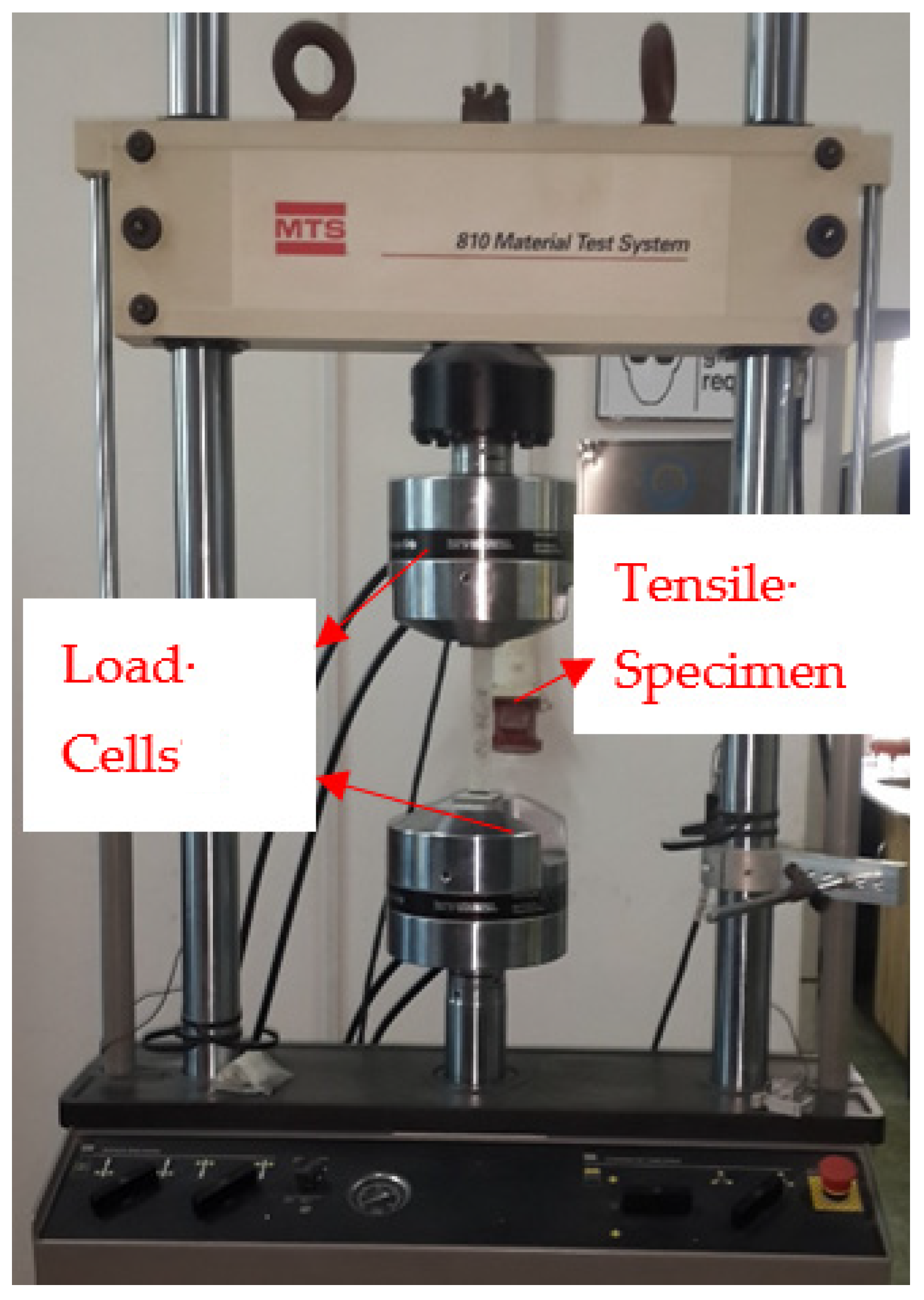
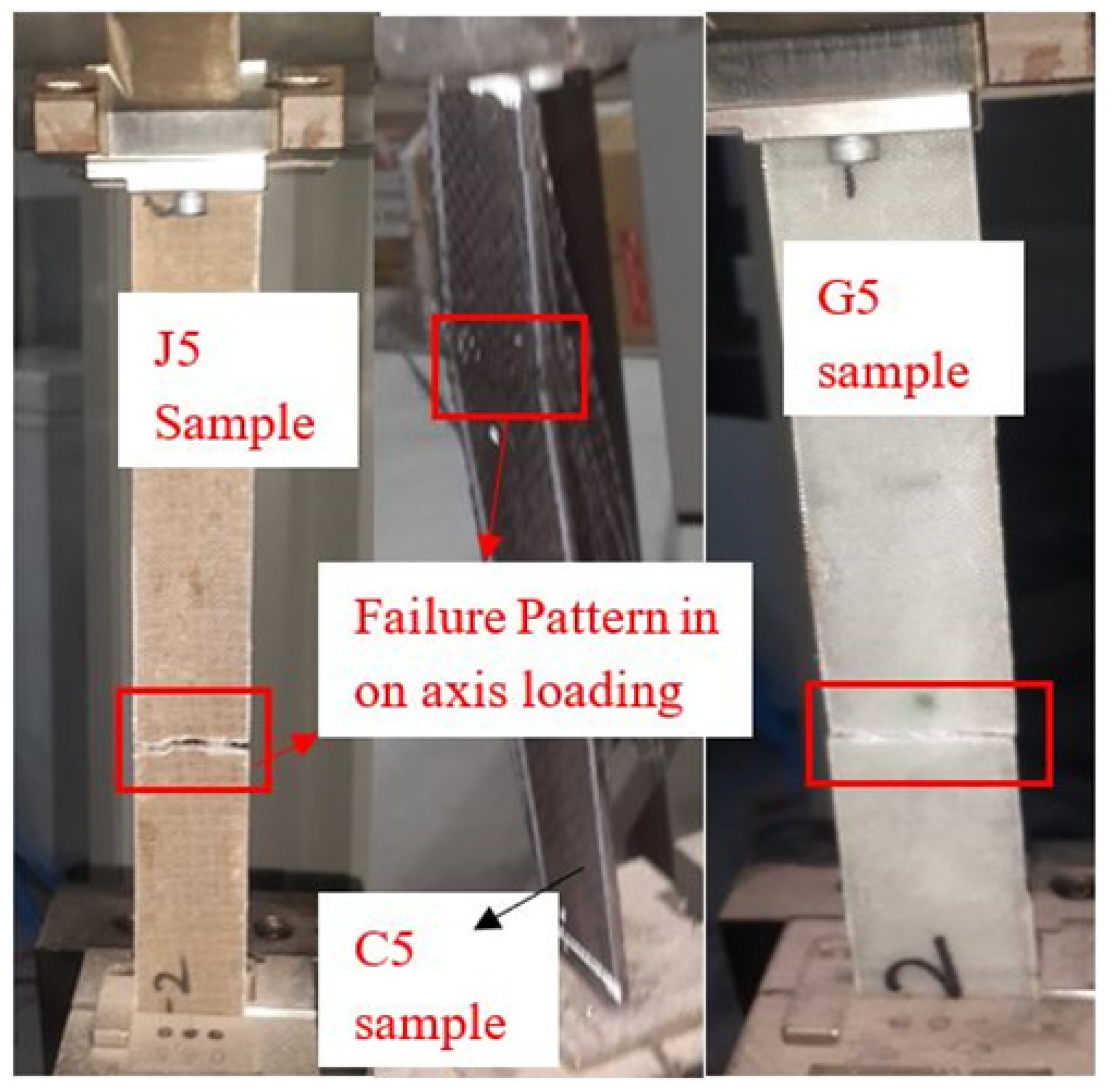
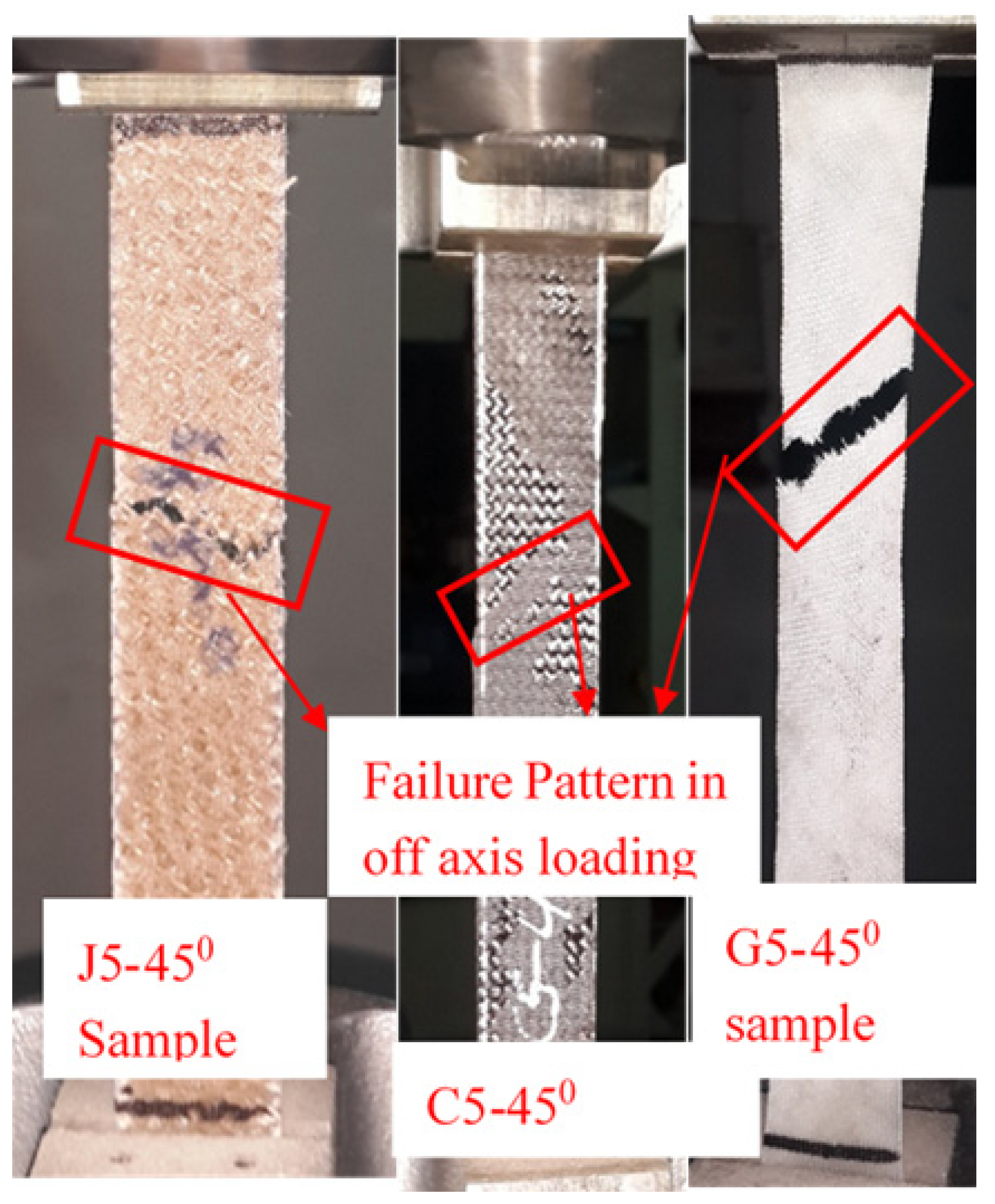

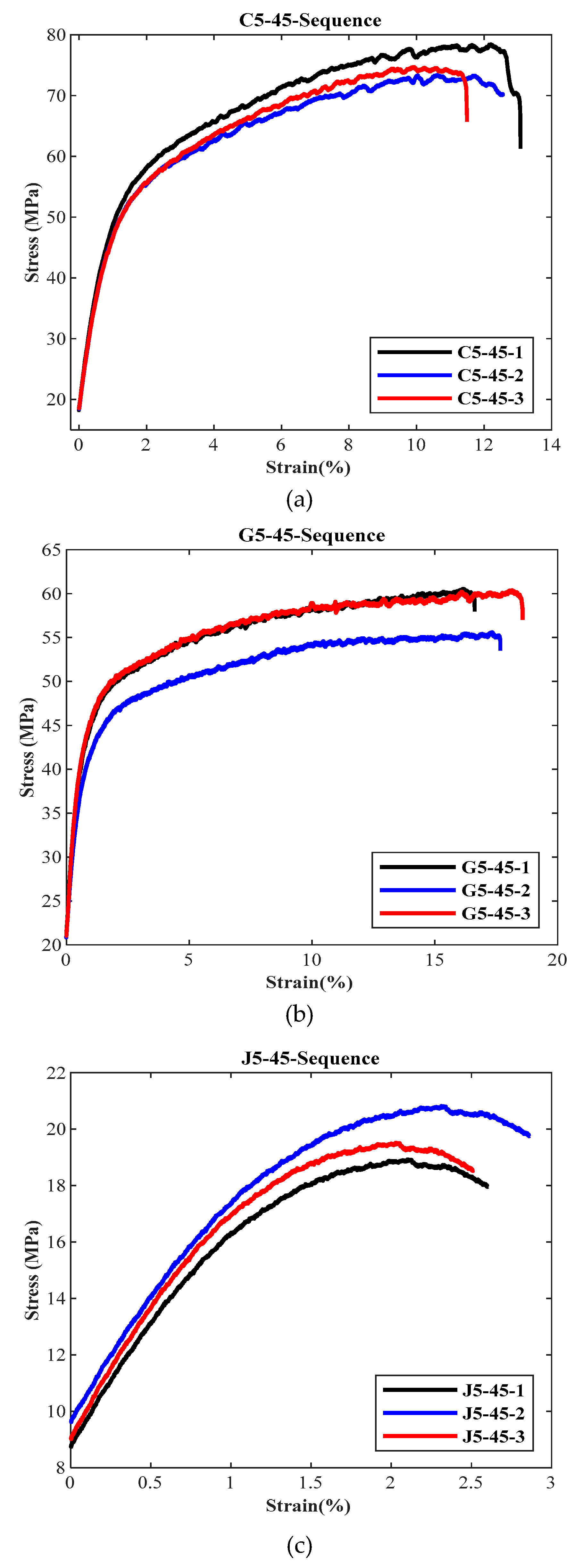
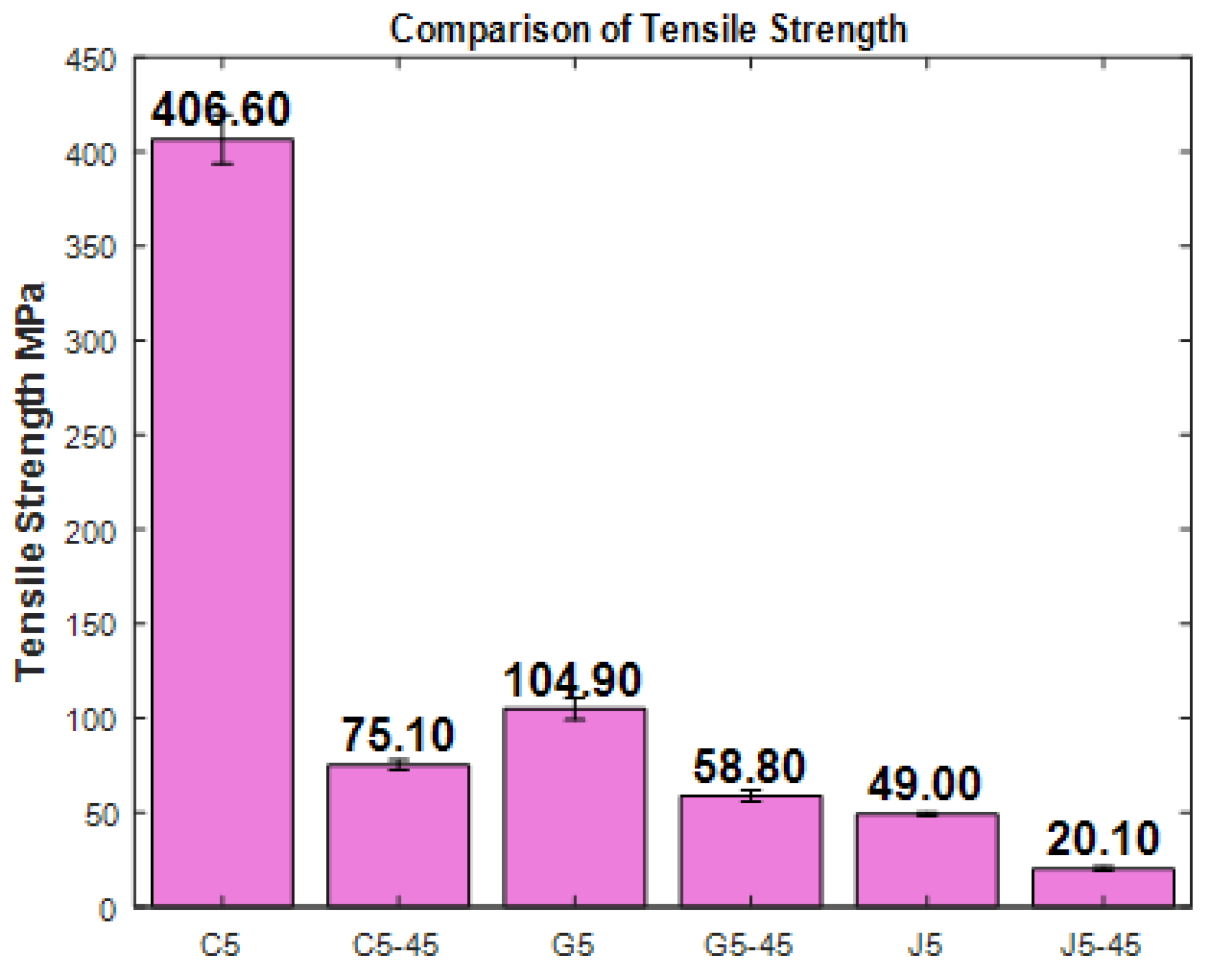

| Fabric/Reinforcement | Matrix Type | GSM (g/m2) | Woven Type | Thickness of Fabric (mm) | Thread Count per 100 mm | |
|---|---|---|---|---|---|---|
| Warp | Weft | |||||
| E-Glass | EPOTEC YD 128 | 170 | Plain | 0.3 | 60 | 65 |
| Carbon (3K) | 195 | 0.35 | 48 | 48 | ||
| Jute | 235 | 0.75 | 30 | 37 | ||
| Layup Sequence | Designation |
|---|---|
| 5 | G5 |
| 5 | C5 |
| Jute/Jute/Jute/Jute/Jute | J5 |
| Glass/Glass/Glass/Glass/Glass | G5-450 |
| Carbon/Carbon/Carbon/Carbon/Carbon | C5-450 |
| Jute/Jute/Jute/Jute/Jute | J5-450 |
| Layup Sequence | Thickness (t) (mm) | Young’s Modulus (E) (MPa) | (MPa) | (%) |
|---|---|---|---|---|
| G5 | 1.3 | 8507 ± 108 | 105 ± 5.87 | 1.75 ± 0.1 |
| C5 | 1.4 | 17407 ± 341 | 406 ± 13.05 | 3.75 ± 0.1 |
| J5 | 2.9 | 5107 ± 149 | 49 ± 1.08 | 1.3 ± 0.6 |
| Layup Sequence | Thickness (t) (mm) | Young’s Modulus (E) (MPa) | (MPa) | (%) |
|---|---|---|---|---|
| G5-45 | 1.3 | 4125 ± 161.6 | 58.8 ± 3.14 | 17.58 ± 0.94 |
| C5-45 | 1.4 | 4068 ± 345.9 | 75.13 ± 2.66 | 12.32 ± 0.73 |
| J5-45 | 2.9 | 803 ± 15.27 | 20.13 ± 1.25 | 2.72 ± 0.13 |
Publisher’s Note: MDPI stays neutral with regard to jurisdictional claims in published maps and institutional affiliations. |
© 2021 by the authors. Licensee MDPI, Basel, Switzerland. This article is an open access article distributed under the terms and conditions of the Creative Commons Attribution (CC BY) license (http://creativecommons.org/licenses/by/4.0/).
Share and Cite
Khalid, M.Y.; Rashid, A.A.; Arif, Z.U.; Akram, N.; Arshad, H.; García Márquez, F.P. Characterization of Failure Strain In Fiber Reinforced Composites: Under On-Axis and Off-Axis Loading. Crystals 2021, 11, 216. https://doi.org/10.3390/cryst11020216
Khalid MY, Rashid AA, Arif ZU, Akram N, Arshad H, García Márquez FP. Characterization of Failure Strain In Fiber Reinforced Composites: Under On-Axis and Off-Axis Loading. Crystals. 2021; 11(2):216. https://doi.org/10.3390/cryst11020216
Chicago/Turabian StyleKhalid, Muhammad Yasir, Ans Al Rashid, Zia Ullah Arif, Naveed Akram, Hassan Arshad, and Fausto Pedro García Márquez. 2021. "Characterization of Failure Strain In Fiber Reinforced Composites: Under On-Axis and Off-Axis Loading" Crystals 11, no. 2: 216. https://doi.org/10.3390/cryst11020216
APA StyleKhalid, M. Y., Rashid, A. A., Arif, Z. U., Akram, N., Arshad, H., & García Márquez, F. P. (2021). Characterization of Failure Strain In Fiber Reinforced Composites: Under On-Axis and Off-Axis Loading. Crystals, 11(2), 216. https://doi.org/10.3390/cryst11020216










